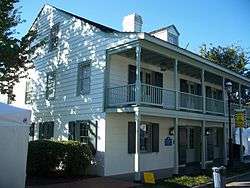Pensacola Historic District
The Pensacola Historic District (also known as the Seville Historic District) is a U.S. historic district (designated as such on September 29, 1970) located in Pensacola, Florida.
Pensacola Historic District | |
 Julee Cottage, in the district | |
  | |
| Location | Pensacola, Florida |
|---|---|
| Coordinates | 30°24′38″N 87°12′36″W |
| Area | 108 acres (44 ha) |
| NRHP reference No. | 70000184[1] |
| Added to NRHP | September 29, 1970 |
| Wikimedia Commons has media related to Pensacola Historic District. |
The district is roughly bounded by Bayfront Parkway, Tarragona, Romana and Cevallos Streets. Within the district are the Historic Pensacola Village, the T.T. Wentworth Jr. Florida State Museum and Seville Square. Seville Square and its twin, Plaza Ferdinand VII, were the parade grounds for the Fort of Pensacola established during British rule. In 1559, a site to the northeast of the Pensacola Historic District on the Pensacola Bay is the earliest known European settlement on the North American continent.[2]
Establishment
In the early 1960s a group of local preservationists led by Pensacolian Mary Turner Rule (née Reed) formed the Pensacola Heritage Foundation, joined the National Trust, surveyed the Seville Square Historic District, the neighborhood around Seville Square adjacent to Pensacola Bay. Realizing the importance of Pensacola's history and the need to save it, Rule and the Heritage Foundation conducted the research and submitted the paperwork to have the Pensacola Historic District listed on the National Register of Historic Places. The group purchased the important Dorr House on the square, restoring it with their own labor starting the preservation movement. They convinced the city to bring the deteriorated square to its present-day restored state. Then they created a festival, a hometown Victorian picnic in the park, An Evening in Old Seville Square, to bring Pensacolians to the district encouraging restoration. Rule had the famous lighthouse at the Navy Air Station listed on the National Register. She also helped create a state board now called the N.W. Florida Preservation Board, whose function is to protect the Seville Square Historic District and Pensacola's history. The city established the Architecture Review board to protect Pensacola's history locally.[3]
Historic Pensacola Village

Historic Pensacola (located within the Pensacola Historic District) is a collection of 29 historical buildings and museums[4] managed by the UWF Historic Trust, a direct support organization of the University of West Florida (UWF). Historic Pensacola is located in downtown Pensacola, Florida, situated between Plaza Ferdinand VII and Seville Square. Parking is available behind the T.T. Wentworth Museum, based in the former City Hall.
The Historic Pensacola Village museum complex is largely by UWF staff, some paid UWF students, and many volunteers.
Visiting information
Admission is purchased for a week, and includes access to the entire complex and guided tour of several historic buildings. These buildings can be entered by visitors only during the tour.
The museum complex is open for visitors Tuesday through Saturday, from 10:00 a.m. to 4:00 p.m. The T. T. Wentworth, Jr. Museum is open until 7:00 p.m. Thursday-Saturday and from noon until 4:00 p.m. for Half Price Evenings and Sundays. Members receive free admission for one year.
Certain buildings can be rented out for special occasions. In particular, Old Christ Church is popular for weddings, and the Museum of Commerce is popular for events and receptions.
Buildings
The buildings in the complex include:
- T.T. Wentworth Jr. Florida State Museum
- Bowden Building (classrooms and administrative offices)
- Museum of Commerce
- Museum of Industry
- Historic Pensacola's Tivoli High House (ticket and information center)
- Weaver's Cottage
- Julee Cottage
- Lavalle House
- Lear-Rocheblave House
- Old Christ Church
- Dorr House (used by UWF's President as a residence)
- Pensacola Children's Museum - hands-on exploration of Pensacola's colonial history on the first floor, local history exhibits for adults and children on the second floor
Image gallery
 Julee Cottage, 1805
Julee Cottage, 1805 Tivoli House, 1805
Tivoli House, 1805 Clara Barkley Dorr House, 1871, residence of UWF president
Clara Barkley Dorr House, 1871, residence of UWF president Lear Rocheblave House, 1890
Lear Rocheblave House, 1890 Old Christ Church, 1763
Old Christ Church, 1763 T. T. Wentworth, Jr. Florida State Museum
T. T. Wentworth, Jr. Florida State Museum Museum of Commerce
Museum of Commerce Museum of Industry
Museum of Industry
See also
- Historic Pensacola Village
- Pensacola, Florida
- Plaza Ferdinand VII
References
- "National Register Information System". National Register of Historic Places. National Park Service. July 9, 2010.
- Florida, University of West. "Luna Settlement | University of West Florida". uwf.edu. Retrieved 2018-08-13.
- Florida House Bill 163, 1967 "Relating to creating the Pensacola Historical Restoration and Preservation Commission.
External links
- Escambia County listings at National Register of Historic Places
- Escambia County listings at Florida's Office of Cultural and Historical Programs
- Pensacola: Seville Historic District: Seville Square at FilmNorthFlorida
- History of the Historic Seville District at Neighbors in Seville, Inc.
- Pensacola Christmas Market at Seville Square
- Pensacola Sightseeing

